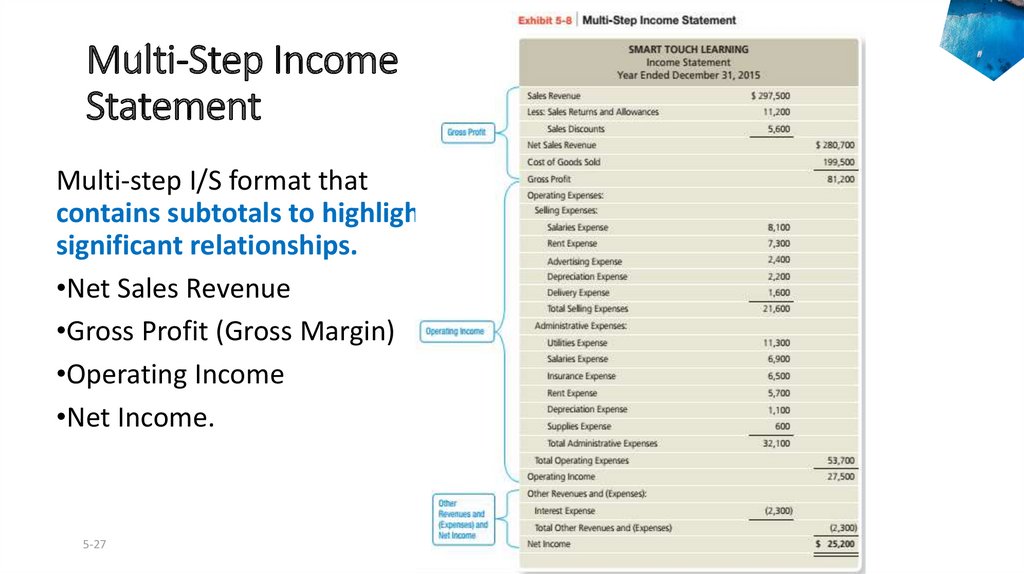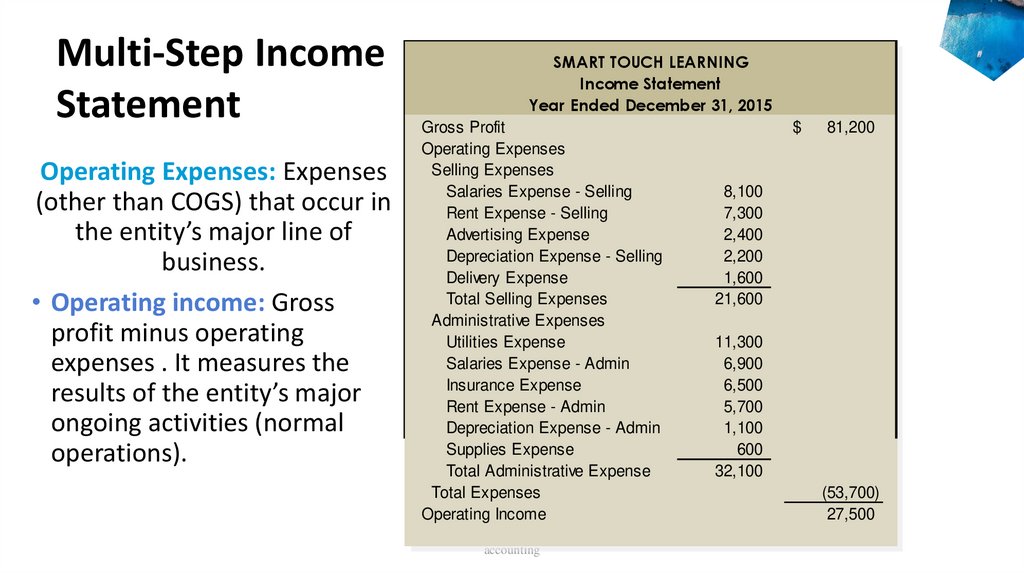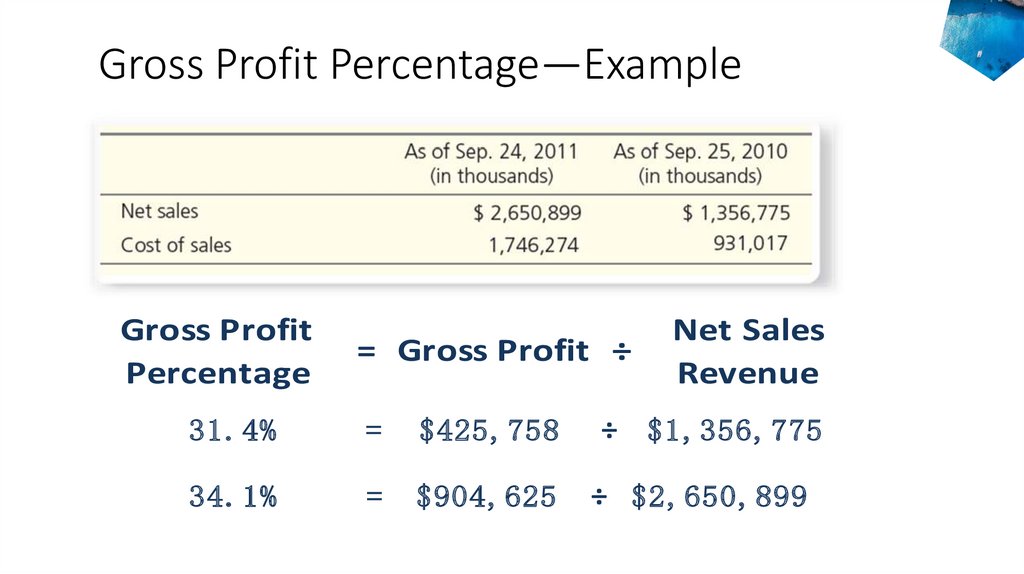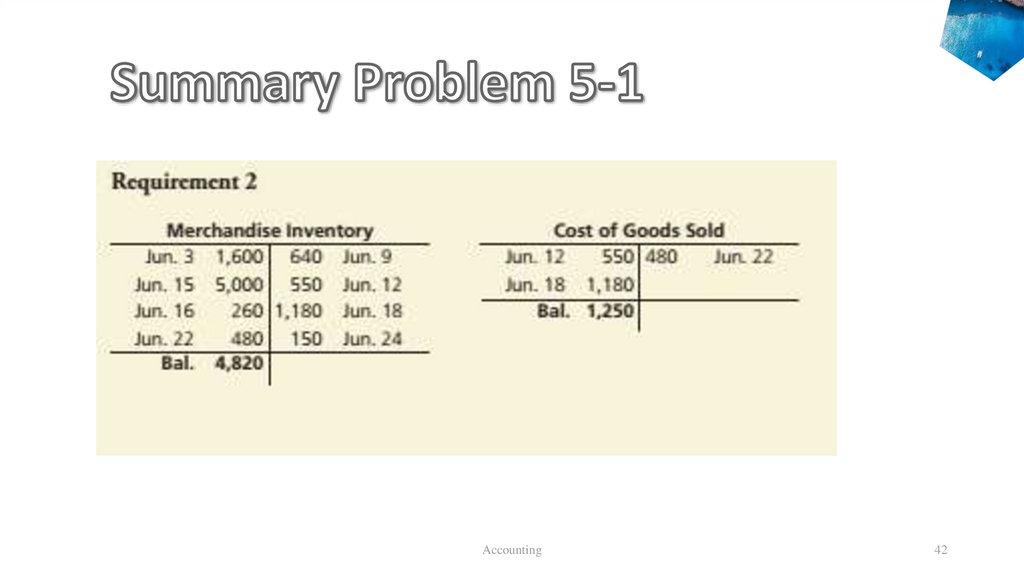Похожие презентации:
Accounting. Merchandising
1.
Ho rn gren ’sAc co u ntin g
Lecture Twelve
Lisa, Li
1
2.
Merchandising Operations- Objective 1Operating Cycle
Merchandising
Perpetual
Operations
Merchandise
Inventory System
Accounting
Periodic
2
3.
PurchaseMerchandise
Inventory
Net Cost of
Inventory
Purchased
Learning Objectives 2
Purchase
Returns
Purchase
Purchase
Discounts
Transportation
cost-Freight in
accounting
Purchase of
merchandise inventory
using perpetual
inventory system
4.
SellMerchandise
Inventory
Learning Objectives 3
Sales Returns
Gross Profit
and
Allowances
Account for the sale of
merchandise inventory
using a perpetual
inventory system
Sales
Net Sales
Revenue
Sales
Discounts
Freight Out
accounting
5.
Homeworkp306
accounting
5
6.
Homeworkp306
accounting
6
7.
Homeworkp342
accounting
7
8.
Homeworkp342
Accounting book for The Textbook Store
Date
Oct. 10
Accounts and Explanation
Merchandise Inventory (2,500 × $15)
Debit
Credit
Date
Oct. 10
37,500
Accounts Payable
Accounting book for Piranha(seller)
37,500
Purchased inventory on account
Oct. 13
Accounts Payable (100 × $15)
1,500
Merchandise Inventory
1,500
Returned inventory to seller
Oct. 22
Accounts Payable ($37,500 − $1,500)
Cash ($36,000 – $720)
Merchandise Inventory ($36,000 × 0.02)
Oct. 13
36,000
35,280
720
Paid within discount period net of return
Oct. 22
accounting
Accounts and Explanation
Debit
Accounts Receivable (2,500 × $15)
Sales Revenue
Sale on account
37,500
Cost of Goods Sold
Merchandise Inventory
Record cost of goods sold
22,500
Sales Returns and Allowances (100 × $15)
Accounts Receivable
Received returned goods
Merchandise Inventory
Cost of Goods Sold
Placed goods back in inventory
Cash ($36,000 − $720)
Sales Discounts ($36,000 × 0.02)
Accounts Receivable ($37,500 − $1,500)
Cash collection within discount period net of
return
Credit
37,500
22,500
1,500
1,500
900
900
35,280
720
36,000
8
9.
Learning Objectives– Chapter 5
1. Describe merchandising operations
and the two types of merchandise
inventory systems
2. Account for the purchase of
merchandise inventory using a
perpetual inventory system
3. Account for the sale of
merchandise inventory using a
perpetual inventory system
Accounting
9
10.
Learning Objectives– Chapter 5
4. Adjust and close the accounts of a
merchandising business
5. Prepare a merchandiser’s financial
statements
6. Use the gross profit percentage to
evaluate business performance
Accounting
10
11.
SellMerchandise
Inventory
Learning Objectives 3
Sales Returns
Gross Profit
and
Allowances
Account for the sale of
merchandise inventory
using a perpetual
inventory system
Sales
Net Sales
Revenue
Sales
Discounts
Freight Out
accounting
12.
4. Transportation Cost - Freight Out• The freight in is part of the inventory cost for the buyer.
• The freight out is a delivery expense to the seller.
• Smart Touch Learning pays $30 to ship the June 21 sale to the
customer.
Date
Accounts and Explanation
June 21 Delivery Expense
Cash
Paid a freight bill.
5-12
accounting
Debit
30
Credit
30
13.
5. Net Sales RevenueFor the year, Smart Touch Learning sells $297,500 of merchandise
inventory. They process $11,200 of sales returns and allowances,
and they award $5,600 of sales discounts.
What is Net Sales Revenue for the year?
Net Sales
Revenue
5-13
Sales
=
Revenue
Sales Returns
Sales
and
Discounts
Allowances
accounting
14.
5. Net Sales RevenueFor the year, Smart Touch Learning sells $297,500 of merchandise
inventory. They process $11,200 of sales returns and allowances,
and they award $5,600 of sales discounts.
What is Net Sales Revenue for the year?
5-14
accounting
15.
6. Gross Profit• The difference between Net Sales Revenues and Cost of Goods
Sold
• Indicates the amount available to cover operating expenses
• For this example, assume Smart Touch Learning’s Cost of Goods
Sold is $199,500; its gross profit is calculated as follows:
5-15
accounting
16.
Practice Questionsp312
accounting
16
17.
Practice Question Solutionsaccounting
17
18.
Learning Objectives 4Adjust and close the
accounts of a merchandising
business
Accounting
18
19.
Adjusting Merchandise Inventory• At the end of the period, actual inventory on hand may
differ from the accounting records in perpetual inventory
system.
• This difference can occur because of:
• Theft
• Damage
• Errors
• ‘Merchandise Inventory’ account must be adjusted at the
end of the period
accounting
20.
Adjusting Merchandise Inventory• Smart Touch Learning’s Merchandise Inventory account shows an
unadjusted balance of $31,530,with no theft or error. But on
December 31, ST Learning counts the inventory on hand, and the
total cost comes to only $31,290.
• ST Learning records this adjusting entry for inventory shrinkage. And the
entry brings Merchandise Inventory to its correct balance.
accounting
21.
Closing the Accounts of a Merchandiser1. Close R to Income Summary
2. Close E and contrarevenues(-R) to Income
Summary
3. Close Income Summary to
Capital
4. Close Withdrawals to Capital
5-21
accounting
22.
Closing in aMerchandiser
5-22
accounting
23.
Closing the Accounts of a Merchandiser• At this point, the Income Summary account has a $25,200 balance.
• Next, we need to close Income Summary to the Capital account.
5-23
accounting
24.
Learning Objectives 5Prepare a merchandiser’s
financial statements
Accounting
24
25.
Merchandiser’s Financial Statements1. Income Statement
Single-Step Income Statement
Multi-Step Income Statement (common approach)
2. Change in owner’s equity
3. Balance Sheet
The report format (A at top, L and O/E at bottom)
The account format (A at left, L and O/E at right)
4. Cash flow Statement
5-25
accounting
26.
Single-Step Income StatementSMART TOUCH LEARNING
Income Statement
Year Ended December 31, 2015
Revenues
Net Sales Revenue
$ 280,700
Expenses
Cost of Goods Sold
$ 199,500
Salaries Expense
15,000
Rent Expense
13,000
Utilities Expense
11,300
Insurance Expense
6,500
Depreciation Expense
3,300
Advertising Expense
2,400
Interest Expense
2,300
Delivery Expense
1,600
Supplies Expense
600
Total expenses
255,500
Net income
$ 25,200
Income statement format
that groups all revenues
together and then lists
and deducts all expenses
together without
calculating any subtotals.
accounting
27.
Multi-Step IncomeStatement
Multi-step I/S format that
contains subtotals to highlight
significant relationships.
•Net Sales Revenue
•Gross Profit (Gross Margin)
•Operating Income
•Net Income.
5-27
accounting
28.
Multi-Step IncomeStatement
COGS: is also called Cost of
Sales. It represents a functional
expense.
Gross profit: Net Sales
Revenue minus COGS. It is
the extra sale amount the
company receives from the
customer over what the
company paid to the vendor.
SMART TOUCH LEARNING
Income Statement
Year Ended December 31, 2015
Sales Revenue
$ 297,500
Less: Sales Returns & Allowances
(11,200)
Sales Discounts
(5,600)
Net Sales Revenue
Cost of Goods Sold
Gross Profit
$ 280,700
(199,500)
81,200
Let's look at the rest of the Multi-Step
Income Statement
accounting
29.
Multi-Step IncomeStatement
Operating Expenses: Expenses
(other than COGS) that occur in
the entity’s major line of
business.
• Operating income: Gross
profit minus operating
expenses . It measures the
results of the entity’s major
ongoing activities (normal
operations).
SMART TOUCH LEARNING
Income Statement
Year Ended December 31, 2015
Gross Profit
Operating Expenses
Selling Expenses
Salaries Expense - Selling
Rent Expense - Selling
Advertising Expense
Depreciation Expense - Selling
Delivery Expense
Total Selling Expenses
Administrative Expenses
Utilities Expense
Salaries Expense - Admin
Insurance Expense
Rent Expense - Admin
Depreciation Expense - Admin
Supplies Expense
Total Administrative Expense
Total Expenses
Operating Income
accounting
$
81,200
8,100
7,300
2,400
2,200
1,600
21,600
11,300
6,900
6,500
5,700
1,100
600
32,100
(53,700)
27,500
30.
Multi-Step Income StatementSMART TOUCH LEARNING
Income Statement
Year Ended December 31, 2015
Operating Income
Other Revenues & Expenses
Interest Expense
(2,300)
Total Other Revenue & Expenses
Net Income
$
27,500
$
(2,300)
25,200
• Other revenues and expenses: Revenues or expenses that are outside
the normal, day-to-day operations of a business, such as interest
expense, taxes, etc.
• Finally, Net Income is determined by subtracting Other Revenues and
Expenses from Operating Income.
accounting
31.
Statement of Owner’s Equity and the B/S• A merchandiser’s statement of owner’s equity looks exactly
like that of a service business.
• Merchandisers have an additional CA, Merchandise Inventory.
Service businesses do not have it in B/S.
Accounting
31
32.
Learning Objectives 6Use the gross profit
percentage to evaluate
business performance
Accounting
32
33.
Gross Profit PercentageGross Profit
Percentage
= Gross Profit ÷ Net Sales Revenue
• Measures the profitability of each sales dollar.
• When this number is trending downward, it can indicate a
significant problem.
• Useful profitability ratios
34.
Gross Profit Percentage—ExampleGross Profit
Percentage
= Gross Profit ÷
31.4%
=
$425,758
34.1%
=
$904,625
Net Sales
Revenue
÷ $1,356,775
÷ $2,650,899
35.
Gross Profit Percentage—Example36.
Gross Profit Percentage—Examplea.
$27,740
($87,940 − $60,200)
b.
$3,524
($103,600 − $99,200 − $876)
c.
$65,180
($99,200 – $34,020)
37.
Gross Profit Percentage—Examplea.
$27,740
($87,940 − $60,200)
b.
$3,524
($103,600 − $99,200 − $876)
c.
$65,180
($99,200 – $34,020)
d.
$64,200
($66,200 – $1,600 – $400)
e.
$23,700
($64,200 – $40,500)
f.
$115,500 ($112,520 + $2,086 + $894)
g.
$112,520 ($75,800 + $36,720)
38.
Practice Questionaccounting
38
39.
Practice Questiona. Sales – they should try to increase sales, a higher Sales will increase Gross
Profit Percentage
b. Sales Returns and Allowances – they should try to decrease sales returns
and allowances, a higher Sales Returns and Allowances will decrease Gross
Profit Percentage
c. Cost of Goods Sold – they should try to decrease cost of goods sold, a
higher Cost of Goods Sold will decrease Gross Profit Percentage
d. Sales Discounts – they should try to decrease sales discounts, a higher
Sales Discount will decrease Gross Profit Percentage
accounting
39
40.
Accounting40
41.
Accounting41
42.
Accounting42
43.
HomeworkThe adjusted trial balance of Leading Business Systems at March 31, 2015, follows:
LEADING BUSINESS SYSTEMS
Adjusted Trial Balance
March 31, 2015
Balance
Account Title
Debit
Credit
Cash
Accounts Receivable
Merchandise Inventory
Office Supplies
Equipment
Accumulated Depreciation—
Equipment
Accounts Payable
Salaries Payable
Notes Payable, long-term
Wright, Capital
Wright, Withdrawals
Sales Revenue
Sales Returns and Allowances
Sales Discounts
Cost of Goods Sold
Selling Expense
Administrative Expense
Interest Expense
Total
$3,000
10,000
40,000
7,500
45,000
Requirements
1. Journalize the required closing entries at March 31, 2015.
2. Set up T-accounts for Income Summary; Wright, Capital; and Wright,
Withdrawals. Post the closing entries to the T-accounts and
calculate their
ending balances.
$18,000
15,000
2,500
11,100
50,000
55,000
3. How much was Leading’s net income or net loss?
4. Prepare Leading’s multi-step income statement for the year ended
March 31, 2015.
300,000
3,000
2,500
180,000
30,000
18,000
2,600
$396,600
$396,600
5-43












































 Маркетинг
Маркетинг








